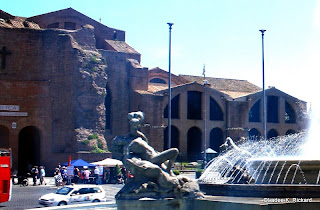Fountain of the Naiads was originally the fountain of the Acqua Pia. It was connected to the aqua Marcia aqueduct. The two statues on the side of the fountain in the photo below are the (left) Nymph of the Lakes (recognizable by the swan that she holds) and the (right) Nymph of the Rivers (stretched out on the monster of the river).
On the right is the Nymph of the Oceans riding a horse symbolizing the sea, and on the left is the Nymph of the Underground Waters, leaning over a mysterious dragon. The sculptures were done by Mario Rutelli. The statue in the middle of the fountain is known as the "Glaucus" group. It is believed that Glaucus came to the rescue of sailors and fishermen.
Note: We did not go in this Basilica, but I certainly have learned a lot researching this building that just happened to make it in to a corner of one of my photos. The building on the left is the Basilica S. Maria degli Angeli e du Martiri (Basilica of Saint Mary of the Angels and the Martyrs). It is a titular basilica church in Rome built inside the frigidarium of the Baths of Diocletian. (I had to research most of these words, so click on the basilica link to see what your unknown words mean.) My favorite artist Michelangelo worked for about a year 1563-1564 on the remaining structure of the baths to adapt them to the church. Very cool. (hee hee) As I have found in Rome, these churches may look plain on the outside, but the inside is incredible. Here is the best close up view of the basilica that I can get from my pictures.
I thought that the three young tourists in the bottom left were funny with their "nymph" poses. Click on the photo to get an enlarged view.
 You can follow the map as we left Piazza della Repubblica (#1) on Via Nazionale, turned right on Via Milano, and entered the tunnel. The name of the road changed to Via del Trafolo. We then made a right turn on Via de Tritone and drove to Piazza Barberini (#2) and the famous Bernini fountain Fontana del Tritone (Triton Fountain).
You can follow the map as we left Piazza della Repubblica (#1) on Via Nazionale, turned right on Via Milano, and entered the tunnel. The name of the road changed to Via del Trafolo. We then made a right turn on Via de Tritone and drove to Piazza Barberini (#2) and the famous Bernini fountain Fontana del Tritone (Triton Fountain). 
Here are three views of the Triton fountain. The first view above is from the front as we entered the plaza and the side view as we passed through. The fountain from the back view also shows you that we are on a slight hill as the street behind it descends.
While researching this area, I read that there was another Bernini fountain in the area. I looked carefully through my photos and was able to catch a glimpse of it. It is the Fontana delle Api. You can see it to left of the white bus. The first photo is a general shot to give an idea of the location, then the second one zooms in on the shell fountain. It was on the right side of the bus as we passed it, and I was on the left. Oh well, I will see it another time but at least I know that it is here.
We also passed by the Boscolo Palace Romo (#4 on the map). This hotel is owned by Boscolo Hotels and in 2010 the hotel was restored to its former glory following the design of architect Italo Rota. Take a moment and look at the interior. The website for the hotel is http://palace-roma.boscolohotels.com/
If you are interested in architecture, the supervising architect Diego Terna (from Studio Italo Roto) describes the ideas of Italo Roto on this video.
http://www.sfuitaliadesign.com/2010/studio-italo-rota He speaks English throughout the video.
As is true in all of Rome, you see art and architecture from the past in the immediate area of new creations from today's greats.












1 comment:
Thanks for the beautiful tour. I don't think I saw these when I was in Rome, but then again, there are wonderful things around every corner and they begin to blend together!
Post a Comment